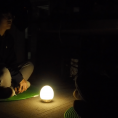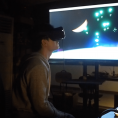
Flying dreams have the potential to evoke a feeling of empowerment (or self-efficacy, confidence in our ability to succeed) and self-transcendent experience (STE), which have been shown to contribute to an individual’s overall well-being. However, these exceptional dreaming experiences remain difficult to induce at will. Inspired by the potential of Virtual Reality (VR) to support profound emotional experiences, we explored if a VR flying interface with more embodied self-motion cues could contribute to the benefits associated with flying dreams (i.e., STE and empowerment). Our results indicated that a flying interface with more self-motion cues indeed better supported STE and empowerment. We derived several design considerations: obscurity, extraordinary light and supportive setting. Our results contribute to the discourse around design guidelines for self-transcendence and empowerment in VR, which may further be applied to the improvement of mental well-being.





